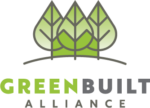Air Sealing Checklist
Air sealing is a crucial part of building a healthy, energy-efficient home. Below is a checklist of items to use to ensure proper air sealing when building or renovating a conventional stick-frame home. A leaky home will decrease the R-value of your insulation (the measure of how well your insulation resists heat flow), create unwanted drafts and comfort issues, and bring moisture and pollutants into the home. As the saying goes, “Seal it tight, and insulate it right!”
- All holes or penetrations in the building envelope are sealed with a material capable of stopping airflow, such as caulk, foam or rigid material (fibrous insulation does not stop airflow).
- Windows and exterior doors are sealed with backer rod, caulk or non-expanding spray foam.
- Electrical, plumbing and HVAC penetrations between conditioned and unconditioned space are sealed with caulk or spray foam.
- The bottom and top plates of exterior walls and walls to the attic are sealed with caulk or sill seal.
- Band joists are sealed with caulk, spray foam, or gasketing between the top plate and band joist, between band joist and subfloor and at any penetration. Any joists or other cavities that span from conditioned to unconditioned spaces are blocked off and air sealed.
- All chase ways that would allow unconditioned air to enter into the conditioned building envelope are capped and sealed.
- Exterior walls behind tub and shower enclosures are insulated. Prior to installing the tub or shower, a rigid, durable air barrier is installed in direct contact with the insulation.
- Insulation wind baffles to block windwashing at all attic eave bays in roof assemblies with soffit vents are installed.
- An air barrier is blocking any exposed edges of insulation, particularly for cantilevered floor systems and floors above a garage.
- For fireplace cavities on exterior walls a rigid air barrier is fully aligned with the insulated framing in the framed shaft behind the fireplace and any gaps are fully sealed with foam, caulk or tape.
- For porch roofs, a rigid air barrier is installed at the intersection of the porch roof and exterior wall.
- For dropped ceilings, a rigid air barrier is fully aligned with insulated framing and any gaps fully sealed with caulk or foam.
- Recessed light fixtures (if installed in insulated cavities, such as the ceiling between the house and the attic) are rated ICAT (Insulation Contact, Air Tight). Once installed, they are sealed to the drywall with gasket, caulk or foam.
Sources for this fact sheet include Advanced Energy System Vision Guidelines, Southface Energy Institute Technical Bulletins, HealthyBuilt Homes program guidelines and Energy Star guidelines for homes and indoor quality.
You can also view this article as it was originally published on page 66 of the 2016-2017 edition of the directory or as a pdf.

